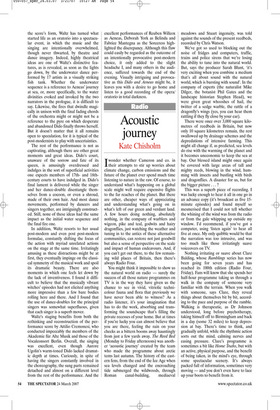Fire and water
Giannandrea Poesio
Dido and Aeneas Sasha Waltz and Guests, Sadler's Wells Theatre
It is not surprising that Baroque operas have long attracted the interest of contemporary choreographers. Apart from the numerous dance passages that punctuate these works, their classically inspired plots, rife with political, cultural and social metaphors, are inexhaustible and stimulating sources of inspiration for any modernday artist. Not to mention the fact that a radical and often intentionally irreverent take on much-revered ‘important’ masterworks is a well-established trait of postmodern dance-theatre making.
Sasha Waltz’s 2005 staging of Purcell’s Dido and Aeneas is one of the most recent additions in the long series of choreographic translations of early operas and oratorios. And it is a daring choice, too, for Purcell’s masterwork had already been successfully turned into modern and postmodern dance a few times, most memorably by Mark Morris.
Waltz’s unique approach to both dance and theatre makes this work stand out from any other production, though. Unlike her predecessors, who remained faithful to the score’s form, Waltz has turned what started life as an oratorio into a spectacular event, in which the music and the singing are intentionally overwhelmed, though never thwarted, by theatre and dance imagery. Indeed, highly theatrical ideas are one of Waltz’s distinctive features, as is revealed, as soon as the lights go down, by the underwater dance performed by 17 artists in a visually striking fish tank. Whether the underwater sequence is a reference to Aeneas’ journey at sea, or, more specifically, to the water divinities evoked and invoked by the two narrators in the prologue, it is difficult to say. Likewise, the fires that dwindle magically in unison with the final fading chords of the orchestra might or might not be a reference to the pyre on which desperate and abandoned Dido finally throws herself. But it doesn’t matter that it all remains open to speculation, for it is typical of the post-modernists to play with uncertainties.
The rest of the performance is not as captivating, although there are other great moments and great ideas. Dido’s court, unaware of the sorrow and fate of its queen, is amusingly overdressed and indulges in the sort of superficial activities one expects members of 17thand 18thcentury courts to have indulged in. Dido’s final lament is delivered while the singer and her dance-double disentangle themselves from a cocoon, or even a shroud, made of their own hair. And most dance movements, performed by dancers and singers together, are intriguingly constructed. Still, none of these ideas had the same impact as the initial water sequence and the final fire one.
In addition, Waltz resorts to her usual post-modern and even post post-modern formulae, constantly shifting the focus of the action with myriad unrelated actions on the stage at the same time. Irritatingly amusing as these distractions might be at first, they eventually impinge on the classical symmetry of the musical work and spoil its dramatic beauty. There are also moments in which one feels let down by the lack of inventiveness. I found it difficult to believe that the musically vibrant witches’ episodes had not elicited anything more impressive than a few bare bodies rolling here and there. And I found that the use of dance-doubles for the principal singers was somewhat superfluous, given that each singer is a superb mover.
Waltz’s staging benefits from both the rethinking and reconstruction of the performance score by Attilio Cremonesi, who conducted impeccably the members of the Akademie für Alte Musik and those of the Vocalconsort Berlin. Overall, the singing was excellent, even though Aurore Ugolin’s warm-toned Dido lacked dramatic depth at times. Curiously, in spite of having the singers constantly involved in the choreography, the sung parts remained detached and almost on a different level from the rest of the performance. And the excellent performances of Reuben Willcox as Aeneas, Deborah York as Belinda and Fabrice Mantegna as the Sorceress highlighted the discrepancy. Although this flaw could easily be regarded as the outcome of an intentionally provocative post-modern choice, it only added to the slight headache I, and many others in the audience, suffered towards the end of the evening. Visually intriguing and provocative as this Dido and Aeneas might be, it leaves you with a desire to go home and listen to a good recording of the opera/ oratorio in total darkness.



















































































 Previous page
Previous page